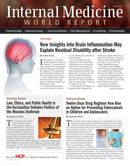Publication
Article
Internal Medicine World Report
Echopulse Efficacy in Benign Thyroid Treatment
Author(s):
Latest study results had revealed a new medication could potentially be a key tool in reducing benign thyroid nodules.

Latest study results had revealed a new medication could potentially be a key tool in reducing benign thyroid nodules.
According to a recent report, the results came after treating 20 benign thyroid nodules in one study, and 10 benign thyroid nodules in a second study. Research was conducted by one team at the University Hospital of Endocrinology, in Sofia, Bulgaria, and one team at Goethe University Clinic in Frankfurt am Main, Germany. The patients involved, “were assessed by nodule volume determination,” before being treated with the new medication, and were then checked again at 3 and 6 months after the therapy.
The results included a “significant mean thyroid nodule volume reduction of 48.7% 6 months after the procedure.” The “maximum volume shrinkage,” was 93% from baseline. The authors also noted “significant decrease (from 2.6 to 1.9- p+0.022) in the cosmetic score and significant increase in the satisfaction score (8.8 from 10), confirming the treatment’s effect and the patient’s approval.
In other published results, thyroid nodule volume “was significantly reduced by a median of 48.8% 3 months following the procedure (p<0.05). There was also reported nodule volume shrinkage of up to 75%. The authors noted the positive results came after just one treatment while, “thyroid function was preserved.”
Additionally, only “minor transient side effects,” or those lasting between a week and a month were reported by 2 patients during the study. “In terms of safety, no serious side effects related to the procedure were observed during three months of follow-up, in line with the immediate follow-up observations,” the authors noted.
Roussanka Kovatcheva, a principal investigator said the team was encouraged by the results. “Our study demonstrated that a single procedure with Theracolion Echopulse® induced significant volume reduction in benign thyroid nodules with favorable cosmetic and safety outcomes.”
Kovatcheva referred to it as “a method that avoids interruption of skin integrity, without penetration of the treatment device into the nodule, and causes fewer side effects and no risk of bleeding.”
Because of the noninvasive nature of the procedure, Michal Nuta, MD, chief medical officer of Theraclion said, “These relevant and significant results confirm the efficacy, the durability, and the degree of persistence of the outcomes obtained with our method.” He added, “The good tolerance, the treatment efficacy and the cosmetic advantage are substantial additional benefits for the patients.”
Nuta said the next steps are to “continue to improve our method for an optimal patient-friendly approach and continue our assessment at longer term follow-up.”





